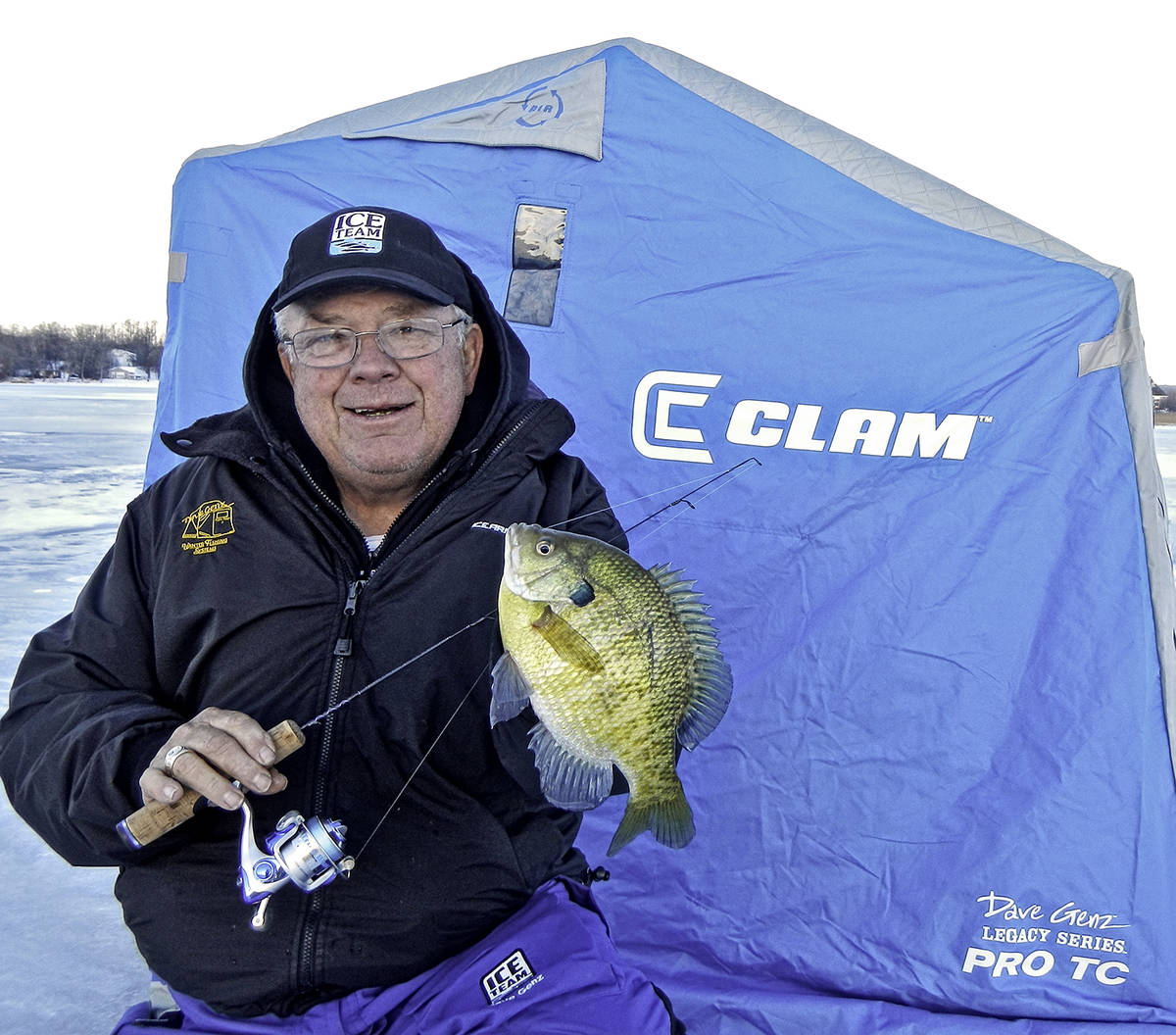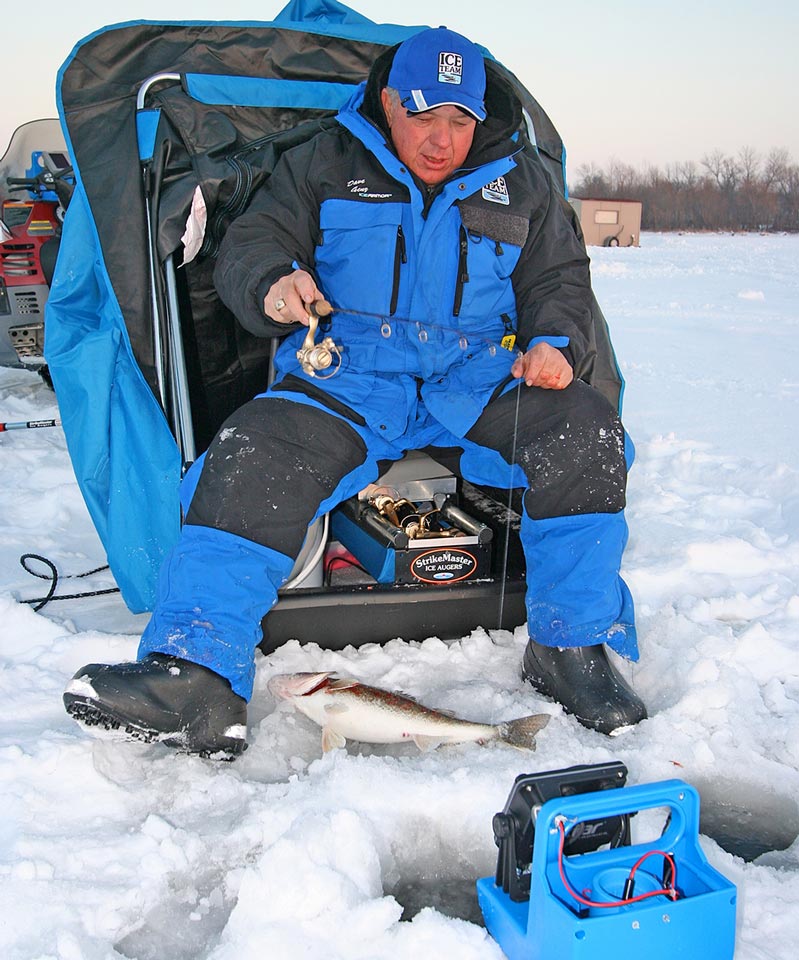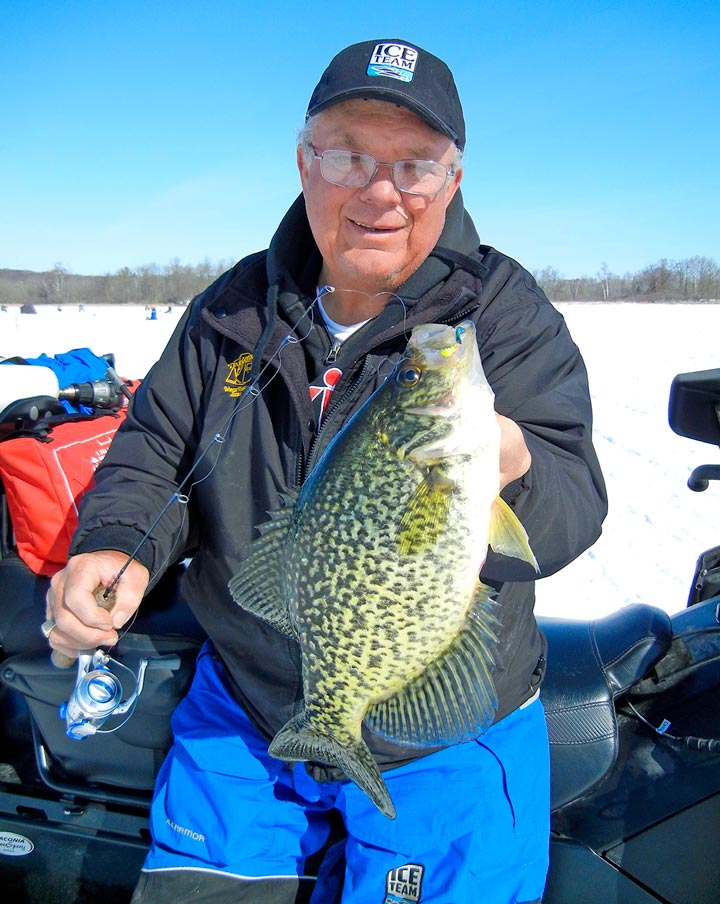Feel the jig, know the bites
At the heart of the ice fishing system Dave Genz pioneered is the belief that we can fish through the ice with the same approach we use in open water. This mindset changed everything about the sport, because it allowed us to take the pursuit to the fish rather than anchoring ourselves over one hole and hoping they show up.
 The system needs a good auger, because you have to bore a hole every place you drop a hook. Beyond that, everything hinges on being able to drop an offering quickly and fish it quickly, to trigger bites from fish that are ready to eat, right now. This is the efficiency factor Genz talks about. Rather than slowly sinking and fluttering something that’s nearly neutrally buoyant, the true Genz approach drops something down there that knows how to sink and get busy attracting fish without wasting time.
The system needs a good auger, because you have to bore a hole every place you drop a hook. Beyond that, everything hinges on being able to drop an offering quickly and fish it quickly, to trigger bites from fish that are ready to eat, right now. This is the efficiency factor Genz talks about. Rather than slowly sinking and fluttering something that’s nearly neutrally buoyant, the true Genz approach drops something down there that knows how to sink and get busy attracting fish without wasting time.
If you spend less time on every ‘drop,’ you can make more drops over the course of a day. It’s a numbers game, a way to cover water. “Every drop down a new hole is like making a cast in the summertime,” says Genz, and the philosophy is solid: there are a lot of fish in the lake, but only a small percentage are ready to bite right now. That’s why you aim to pluck the biters and move on. Keep doing that, and by the end of the day you will have caught more than you would by sitting in one spot.
Ah, but there’s a catch. Fishing this way requires the ability to feel your jig bounce at the bottom of every short, rapid movement of the rod tip. The connection is between your rod, your hand and the weight of the jig. Boomp, boomp, boomp. Feel it and you’re golden, because when the feeling goes away, it often signals that a fish has taken the bait. Hookset time.
Here’s where reality strikes. If your equipment is not crisp and well balanced, it’s difficult or impossible to feel that boomp-boomp-boomp. If your line is too heavy for the weight of the jig (or even if it has taken on coils), you can’t feel the jig. If your rod is too flexible for the weight of the jig, the jig will ‘boing-boing’ up and down like it’s on a trampoline and you won’t be able to feel it well or make it do the dance.
If you can’t feel the bait, you can’t detect the bite.
Even with such an aggressive approach, winter fish often half-heartedly sample things. The take can be so subtle that most of us have a difficult time consistently feeling it. That’s why we see so many bite-detection aids!
Here comes an amazing piece of news: no matter how subtle a bite is, you will feel it if you stop feeling for the bite and instead learn to feel the jig. When the feeling of the jig goes away, set the hook. If you don’t get the fish, assume it didn’t have the hook in its mouth. Next time it happens, drop the rod tip, then set the hook. Usually works wonders.
Once you turn your fishing fortunes over to this approach, you will look like a magician out there, “feeling bites” that others can’t feel.
Because you aren’t feeling for the bite!
“From years of sight fishing, and watching fish on (an underwater) camera,” says Dave, “you know that a fish can totally put the bait in his mouth and there’s no signal up above. Don’t wait to feel a bite. You just have to know that the fish stopped the motion of the lure. That’s what we mean when we talk about feeling the cadence.”
Feel the jig. When the jig is gone, something’s up.
Let’s help you do this, once and for all.
Tightlining with Feel
Genz calls it pounding when you make rapid, short movements of the rod to impart almost a vibrating action to the jig. It looks and feels real to the fish, and is magical in its ability to bring fish in and make them bite.
 The biggest roadblock to fishing well with this approach is separate pieces of gear that are not in tune with one another. The weight of the jig, weight (and freshness) of line, and choice of rod have to match up. Everything has to balance or you can’t perform the pounding presentation – and even if you could, you can’t feel the jig well enough to detect bites.
The biggest roadblock to fishing well with this approach is separate pieces of gear that are not in tune with one another. The weight of the jig, weight (and freshness) of line, and choice of rod have to match up. Everything has to balance or you can’t perform the pounding presentation – and even if you could, you can’t feel the jig well enough to detect bites.
Being able to feel the jig has forever been elusive for most people. They hear Genz talk about feeling for the weight of the bait, and feeling for the absence of the weight of the bait, but just can’t feel it. It becomes frustrating, and most people end up using spring bobbers, floats and other bite-detection aids to make up for the fact that they just can’t feel the jig.
(Quick note: spring bobbers, floats and other devices are effective and have an important place in modern ice fishing. But to fish the Genz pounding presentation, you have to be able to feel the jig.)
There is a degree of talent involved, but most people can feel the jig immediately once they fish with a balanced setup, and it’s never been easier now that there are jigs made of tungsten. Yes, tungsten is a godsend.
Here’s what you need:
- A jig that can catch fish. (Doesn’t matter how well you can feel it if fish don’t like it.)
- A rod that’s light, sensitive and matches up with the jig’s weight.
- Line that’s fresh (and stretched, if necessary, to remove coils) and matched to the weight of the jig. The jig has to remove all coils and cause the line to hang straight down at rest.
- A reel that keeps your line from developing twist and coils.
Gearing up for Balance
This is the winter everything changes for you.
Let’s start with the jigs, but we’ll come back to them, so when you tie one on, you tie everything together.
Jigs
Since the start of the modern ice fishing revolution, Genz has been stressing the importance of “small jigs that fish heavy.” They are a crucial part of the system, and with the development of tungsten jigs, they’re better than ever.
Tungsten jigs are difficult to manufacture, but game-changing to fish with. Comparing apples to apples, tungsten is 70 percent denser than lead, and weighs 30 percent more. Again comparing apples to apples, it’s much easier to feel a tungsten jig bouncing down there than a traditional jig.
Clam, recognizing what a godsend tungsten can be, developed a line of jigs made from the super-dense, super-heavy material. It’s easy to spot a tungsten jig in the Clam Pro Tackle line: if it has Drop in the name, it’s made with tungsten.
Rods
At the top of the Clam rod line is a series called Legacy. “As soon as you pick one up,” says Genz, “you sense the responsiveness it gives you when you’re jigging the lure. It allows better execution of the rapid cadence, and you can feel the lure down there.”
One of the secrets, says Clam’s Matt Johnson, is lighter guides.
“Putting lighter guides on our Legacy rods essentially stiffens the rod,” says Johnson. “It can perform more like a blank without guides on it. The difference is striking.”
Never satisfied with anything, Genz and the people he is surrounded with constantly look for what else ice anglers need. This outlook led to the development of a Medium Light rod action that matches up perfectly with certain tungsten jigs.
“Dave is all about fishing walleyes, northerns, trout, bass during the day,” points out Johnson, “and the number 8 Drop jigs are a perfect size. You can pack ‘em with maggots, wax worms, or a plastic and have a ball.”
 By now, you’ve got a clear picture of how the pieces fit together, and why you can’t declare one rod your ‘favorite’ and attempt to fish all different size jigs on it. “The Medium Light rods,” says Genz, “let you fish the number 8 tungsten Drop jigs on 3-pound and 4-pound-test (line). You’ll catch more fish on this size bait during the daytime hours. Bigger spoons and other baits are great at prime time, but during the day they don’t want a big bait. But the larger Drop jigs are the ticket.”
By now, you’ve got a clear picture of how the pieces fit together, and why you can’t declare one rod your ‘favorite’ and attempt to fish all different size jigs on it. “The Medium Light rods,” says Genz, “let you fish the number 8 tungsten Drop jigs on 3-pound and 4-pound-test (line). You’ll catch more fish on this size bait during the daytime hours. Bigger spoons and other baits are great at prime time, but during the day they don’t want a big bait. But the larger Drop jigs are the ticket.”
Genz describes the need for matching the rod to the line and jig this way: “With number 8 tungsten jigs and our Light action rods, the rod would bend too far when you were trying to pound it. And the Medium action was too stiff. You couldn’t get the cadence we want. We needed this rod weight, because it lets you fish tungsten lures for larger fish in the middle of the day.”
Line: Stronger, Tighter Connection
Because they weigh more for their size, tungsten jigs allow you to use heavier, stronger line and still maintain the balance and feel you’re striving for.
“The lure needs to take the kinks out of the line,” stresses Genz, “and now you can use 4-pound-test with some of the smaller jigs.” Anglers who have typically used line that was too heavy for their smaller jigs, “can suddenly start feeling their lure,” said Genz. “It really helped those people.”
Summary
The equipment allows you to fish this way, and tungsten jigs are a bigger deal than you might think. The rod and line have to be in balance or the links fall apart. It’s all about a distinct connection between you and your bait, and covering water looking for active biters. It’s the essence of ice fishing as Genz practices it most of the time. Only when things don’t work this way does he spend time using slower presentations. Dave carries at least one pre-rigged rod with a spring bobber on it and goes to a “slow it down” approach (often with plastics) at some point on most days. This surprises a lot of people when they first hear it. But that’s a story for another day.
For now, let’s concentrate on getting you balanced up, feeling the jig, and knowing a bite when you don’t feel one.










